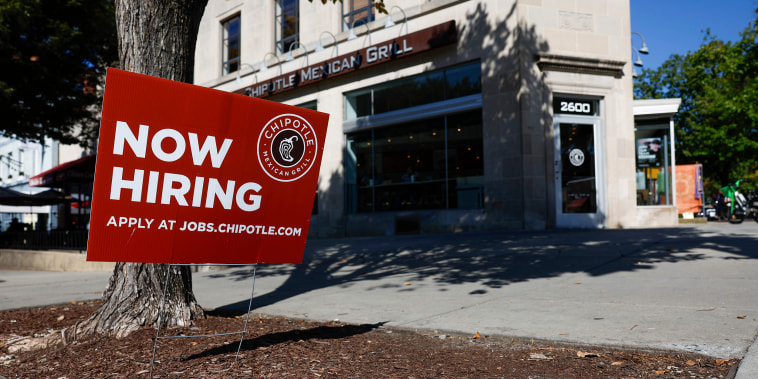The past several months have been dominated by headlines of layoffs at high-profile companies, particularly in the tech industry.
But Friday morning, the Bureau of Labor Statistics reported that the U.S. added 517,000 jobs in January, while the unemployment rate fell to 3.4%, the lowest it’s been in five decades. In total, 5.7 million U.S. workers remain unemployed, the lowest number since 2000.
As University of Michigan economist Justin Wolfers noted in a tweet after the release of the jobs report on Friday morning: ‘Real America is getting back to work.’
‘The labor market is pretty strong,’ said Elise Gould, senior economist at the left-leaning nonprofit Economic Policy Institute, in an interview in advance of Friday’s report. ‘The unemployment rate is low, and there are still people who have not returned to the labor market after the pandemic, so we can expect the labor force can grow. But we’ve had an incredible couple of years of recovery.’
Additional data this week showed the strength of the jobs market: There remained more than 11 million job openings in the economy in December, and the weekly count of first-time filers for unemployment benefits has fallen to 183,000 — a nine-month low.
The jobs gains run counter to the announcements by some brand-name firms in Silicon Valley. A handful of tech companies, including Amazon, Google-parent Alphabet, Facebook-parent Meta, Salesforce, IBM, Intel, Microsoft, Salesforce, Twitter and others have cut thousands of jobs in recent months.
Layoffs are brutal life-altering events. But there is evidence that many of those who’ve lost their jobs have been able to secure new ones in a relatively short period of time.
A recent ZipRecruiter survey conducted in the last three months of 2022 found that more than half of recently hired workers found their job within a month of searching, and more than 4 in 5 found their job within three months.
Even in the hard-hit tech industry, bounce-backs have been robust: ZipRecruiter found that among workers recently laid off from a tech job, 37% found a new job within one month, and 79% found a new job within three months.
Where are companies hiring right now?
Among those bringing in new workers at the moment:
Airplane and airline companies including Alaska Airlines, American Airlines, Boeing, Delta Airlines, Southwest Airlines, and United Airlines Bloomberg LP, which is hiring 1,000 new workersChipotle, which announced it’s looking for 15,000 new workersGeneral Motors told the Detroit Free Press that while this won’t be a “major” hiring year for the automaker, it is continuing to look for tech talent, especially among people laid off in Silicon Valley. The U.S. Postal Service is hiring 2,400 workers in California
The strength of Friday’s jobs report took most economists by surprise — even those who had dismissed the notion that the U.S. was on the brink of a recession.
But at least one group foreshadowed the ongoing jobs boom. The consulting firm Robert Half announced this week that a survey of 2,000 hiring managers showed 58% anticipated adding new permanent roles during the first half of the year, up from 46% just six months ago.
In fact, managers in technology (64%) and finance and accounting (62%) saw the greatest full-time staffing needs. The survey did find 72% of managers plan to hire more contract professionals in the first half of 2023, compared to 45% six months ago.
“Hiring tends to pick up at the beginning of the year, as budgets have been approved and teams seek additional support for initiatives that will drive business growth and customer retention,” said Paul McDonald, senior executive director of Robert Half, in a statement.
“As job openings and turnover remain high, employers need to play offense — and be prepared to negotiate — in order to recruit and retain skilled talent.”
How did we get to this point?
Julia Pollak, chief economist at ZipRecruiter, says the economy is returning to a more ‘balanced’ distribution of job growth after the pandemic sparked massive layoffs in leisure and hospitality, but there’s been an uptick in sectors like warehouse and delivery.
Health care, she said, will be at the forefront, as evidenced by the sector adding 70,000 to 80,000 new jobs each month since last June.
‘The economy is getting back to normal, where job growth is not just being shaped by the pandemic recovery but by longer-term forces like demographics and technological change, which will also be more durable,’ Pollak said in a recent interview.
Green jobs like solar and wind technicians, spurred in part by President Joe Biden’s multibillion-dollar Inflation Reduction Act, are also likely to see outsized growth.
And in Sun Belt states like Texas and Florida, the job growth will be faster than in other parts of the country, Pollak said. Georgia, Kentucky and Michigan are on track to land large electric battery factories that will build the components that power electric vehicles.
Many economists believe a ‘soft landing’ scenario for the U.S. economy that sees inflation slowing while job losses remain low and corporate earnings stay solid is very much in play. One key element for that scenario, at least in the minds of economists, is wage and earnings growth. Friday’s report showed average hourly earnings for lower-wage workers climbed just 0.25%, the smallest increase since January 2021.
Slowing wage growth is not great news for workers. Indeed, their inflation-adjusted ‘real’ wage gains for much of the pandemic and post-pandemic period have been negative because price growth has been so fast.
But EPI’s Gould said that as inflation continues to fall, workers will likely continue to see real earnings gains.
‘Hopefully they’re going to be catching up some to the higher inflation we’ve been seeing last year,’ she said.

